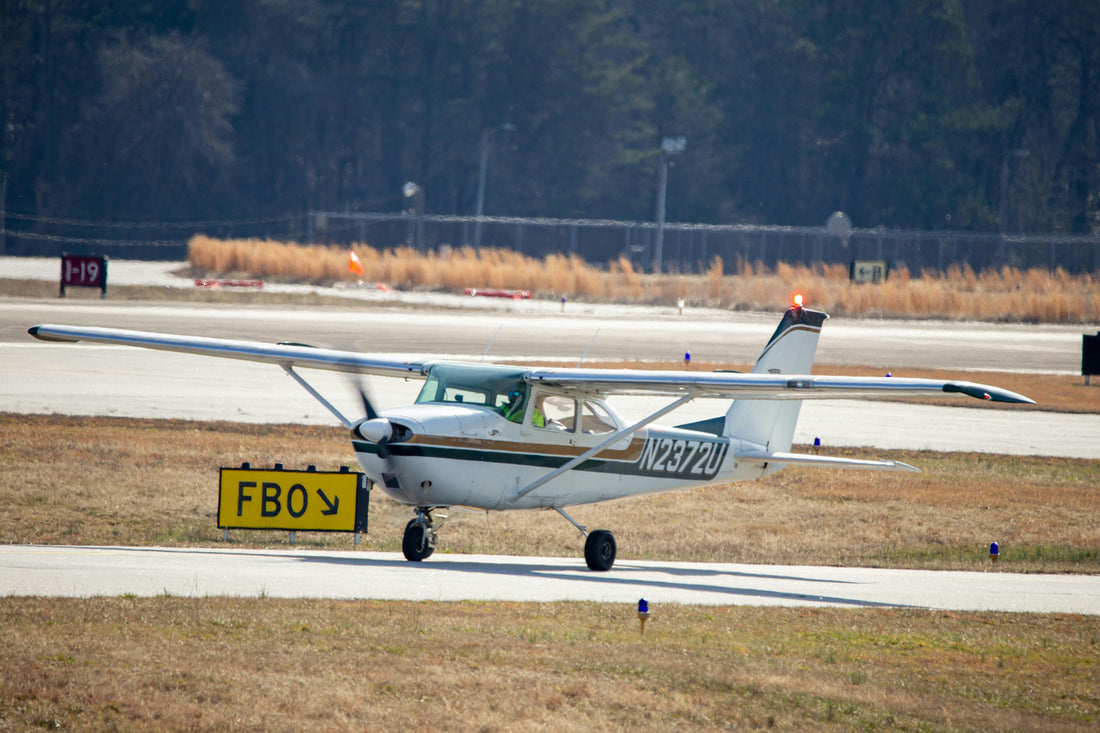
How To Get A Private Pilot License: The Ultimate Guide
By Ally Melick, CRJ Pilot, CFI, CFII, MEI
Over and over, you hear on the news about a pilot shortage and how over the next few years, thousands of pilots will be hired by the airlines. You’ve always dreamt about becoming a pilot, and it seems like now is a great time for a career change.
The only problem is that you don’t know any pilots or aviators who can help guide you on where to start. The task seems daunting, but instead of giving up, you decide to search Google, and it brings you here. Step one on your journey is getting a private pilot's license. Knowing how to get a private pilot license can open the door to a new career or a lifelong passion. Let’s look into all the ins and outs of how to get it.
Why Learning How to Get a Private Pilot License Sets Everything in Motion
Becoming a private pilot gives you the freedom to travel on your terms, sharpen decision-making skills, and fly confidently with family and friends. Aiming to reach the airlines or add advanced ratings like instrument or commercial? Learning how to obtain a private pilot's license is the foundation that supports every subsequent step.
Certificates vs. Rating
When we use the term “private pilot,” we are not talking about the guy who flies Taylor Swift across the Chiefs stadium to her seat. Pilots receive certificates (licenses) as they progress throughout their training, which grant them certain flying privileges.
The first license you will obtain is a student pilot license. This license gives you the privilege to train with a Certified Flight Instructor (CFI) on the basics of flying until you get your private pilot license. Training will be completed in a small 2-4-seat plane with a propeller, called a single-engine aircraft.
The private pilot certificate gives you the privilege to operate the aircraft on your own and bring a couple of friends and family members. As a private pilot, you will be limited to flying only single-engine planes, like those you trained in, and will not be allowed to accept compensation for your flying.
Additionally, pilots get ratings that will act on top of their certificate for added privileges. For example, the instrument rating certifies pilots on navigation using only the instruments inside the cockpit, so they are able to fly with little to no visibility outside. Just like learning to drive, you get a learner's permit, then a driver's license, but you can’t just go drive a semi truck because that’s not included with the privileges of your license.
In order to go to the airlines or become T Swift’s personal chauffeur, you will need to get a student pilot certificate, a private pilot certificate, an instrument rating, a commercial pilot certificate, and possibly an airline transport pilot certificate. Learning how to get a private pilot license is what launches that journey. But let’s not get ahead of ourselves quite yet.
Medical Certificate
The very first thing you will want to do is get a medical certificate. As the risks involved with flying are high, a medical will prove that you will be able to safely operate the aircraft without any concerns regarding your health. There are specific aviation doctors called Aviation Medical Examiners (AME) who can provide this service.
Classes of medicals correspond to certificates, allowing you to act as pilot in command (PIC) with the certificate you hold. If your goal is simply to cruise up in the clouds occasionally, bringing along 1 or 2 passengers, you will only need a third-class medical.
However, if you are planning on continuing your training and working at the airlines, you will eventually need a first-class medical. The requirements are more strenuous for the first-class medical, so it is recommended to get the first-class medical, so there is no question whether or not you will qualify later on.
Depending on your age and the class of medical you receive, you will have to renew this every six calendar months or every 60 calendar months. The Federal Aviation Administration (FAA) provides a list of AMEs on their website so you can easily locate one in your area: https://www.faa.gov/pilots/amelocator.
Picking a Flight School
Aviation is an extremely standardized field and is regulated by the FAA; regulations are laid out in the Federal Aviation Regulations/Aviation Information Manual (FAR/AIM). The FAR/AIM is broken into parts, which are like chapters. Parts 61 and 141 designate types of flight schools.
Part 61 simply lays out the requirements you must meet, like a checklist, and allows training at the CFI’s discretion so long as you check all of the boxes by the time you apply for your private pilot certificate. Part 141 is more formal and structured with a syllabus that will tell you what you will be doing each day and what standards you must meet before moving on to the next task.
Both options have pros and cons, but in the end, it comes down to which is most in line with your learning style and end goal. If you are a fast-paced learner with the goal of working at an airline as quickly as possible, part 141 may be the best pick, and if you would rather take your time and allow your CFI to tailor the training to your learning, then try the 61 route.
Also important to note, part 141 schools are sometimes associated with a university and a 4-year degree. It is also important to pick an instructor whom you like. Visit flight schools around your area and take a discovery flight or 2 to get a tour and ask the following questions to make sure you end up in the right place. Learning how to get a private pilot license starts with finding the right environment to grow your skills.
- What is the availability of planes and instructors?
- What is the pass rate of the school?
- How busy is the airport and practice area?
Costs
Cost is a major aspect of picking a flight school. On average, it costs $7,000-$15,000 to get a private pilot license. Flight schools have different rates for instructors, planes, and club fees. In addition to those general prices, factor in additional costs along the way for things like logbooks, charts, and textbooks, such as a copy of the FAR/AIM and Pilot’s Handbook of Aeronautical Knowledge.
Additionally, more expensive items such as a headset, tablet, flight calculator, and sentry will make your training experience much smoother. Consistency in flight training is key, so saving up funds before beginning training typically results in more success, as you don’t have to continually put your training on hold to get more money.
As a student pilot, the reality is that you don’t need the fanciest plane or the nicest equipment because, at the end of the day, everyone’s certificate says the same thing. The most important thing is that you get into a safe aircraft with a knowledgeable instructor.
Aeronautical Experience
Flight training is typically broken into 3 phases: pre-solo, cross-country, and checkride prep. Additionally, you will complete a ground school course either online or with your CFI. On day one, you will learn how to conduct a preflight check on the aircraft to ensure everything is safe before you take off and the basics of maneuvering the aircraft through climbs, turns, and descents.
As you progress, more complex maneuvers will teach you how to control the aircraft and how to handle it in case of an emergency. Maneuvers and landings will be practiced until you are capable of handling the aircraft from start-up to shutdown without any intervention from your CFI. At this point, you will fly the aircraft by yourself for the first time, completing the pre-solo phase of your training.
The cross-country phase is all about planning and preparation for flights covering distances over 50 nautical miles (equivalent to about 57 statute miles). This portion of training encompasses a lot of work on the ground, learning to read aviation charts and use calculations to determine things such as your flight time and fuel burn.
You will put your calculations to the test with your instructor in the aircraft alongside you, then you will solo again to the planned destination. By this time, you will be almost completely developed and a competent pilot. The one thing left to do is officially get your license.
A three-part test made up of a written, oral, and practical portion conducted by a designated pilot examiner (DPE) must be completed to get your license. This test is called a checkride, and if you’re taking the path to the airlines, you will get extremely familiar with these.
Many people have heard the magic number of 40 hours in order to get your private pilot certificate, but this number is broken down into specific requirements that can be found in FAR part 61.109 or appendix B to part 141. On average, that number comes closer to 80-100 hours. It’s not impossible to get everything done in 40 hours, but don’t get discouraged if it takes a little longer, as everyone’s path in aviation is different.
Congratulations! You have joined the less than 1% of the U.S. population that holds a private pilot license. There is a lot of hard work and dedication that goes into becoming a pilot, and it takes time to complete. After you get your certificate, make sure to take time to explore new places and have fun.
If you're serious about learning how to get a private pilot license, follow this roadmap to stay focused, save time, and enjoy the process. Being a pilot can be an exciting and rewarding career, but enjoying what you do is the most important part to make all the work and cost worth it.
By Ally Melick, CRJ Pilot, CFI, CFII, MEI
Northstar Aviation References brings you the Pre-Tabbed ASA FAR/AIM, DIY tabs for your FAR/AIM and other pilot resources so that you can more easily study the regulations that form the foundation of your flying career or hobby. Have any questions? Check out our FAQs page or contact us. Check out other blog posts here.
